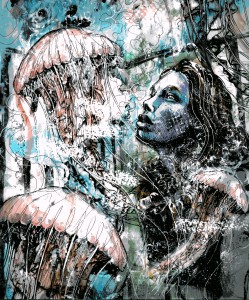Letters by Dr. Walter Matheson, Ph.D., as provided by Jennifer Mitchell
Art by Luke Spooner
Dated 12 June 2015
Dr. Walsh,
I have made a discovery that I think you will find of interest. While collecting water samples with my research assistant, I came across a small species of jellyfish. To me they seemed unremarkable, but I allowed Henry to collect several of them. He took them home to keep as pets, and I completely forgot about them. It turns out that Henry did as well, the poor jellyfish. He came in to the lab upset, and I said to him, you fool, you’re supposed to feed them. I thought that was the last I would hear of these creatures, but of course, if it was, I would not be writing to you.
The day after their death from starvation, Henry brought his tank to the lab. Something curious had happened–jellyfish polyps had appeared in the tank, and the corpses were missing. This was potentially more interesting than our water studies, so I allowed the tank to remain in the lab.
We continued to observe the tank for several days. Over this time, the polyps matured into adult jellyfish. Henry was convinced that these were the original jellyfish, returned to life, but I raised the possibility that they may have simply reproduced before their deaths. Henry is a bright lad, but not always a voice of reason.
Convinced that I was wrong, Henry drained the water from the tank, killing the jellyfish, and flooding the floor of the lab. I was horrified, but he insisted that he would prove me wrong. He refilled the tank with salt water and we waited. The limp jellyfish floated on the surface of the water, and nothing happened. I decided to fire him just as soon as I could find a suitable replacement.
When I arrived at the lab the following morning, the jellyfish were gone. Where the corpses had floated, there were more polyps. In the following days, they regrew into adult jellyfish. At this point, I was convinced in Henry’s theory that these were the same jellyfish that we had originally captured, returning to their earliest stage of life upon death. To be sure, we repeated the original experiment three more times, and each time, the jellyfish returned to their original, living state.
I look forward to receiving your insights into the subject.
Your old friend,
Walter.
~

The day after their death from starvation, Henry brought his tank to the lab. Something curious had happened–jellyfish polyps had appeared in the tank, and the corpses were missing. This was potentially more interesting than our water studies, so I allowed the tank to remain in the lab.
Dated 17 August 2015
Dear Dr. Walsh,
At your suggestion, we have confirmed that the DNA of the jellyfish remains unchanged after their death and rebirth–these are definitely the same individuals. A wonderful discovery for science! My paper on the subject will be printed in Marine Genetics Journal next month.
For the present, I have abandoned my water sample project and am focusing all of my efforts on advancing knowledge of the jellyfish. I have hired another assistant with more knowledge in this area to assist Henry and myself. We are trying to isolate the sequence of DNA that allows the animal to be reborn upon death.
I will be quite busy with this project for the foreseeable future, so it may be a while before I write again.
Walter.
~
To read the rest of this story, check out the Mad Scientist Journal: Autumn 2015 collection.
Dr. Walter Matheson, Ph.D., is a Canadian oceanographer and marine biologist. He is famous for his studies of ocean water, jellyfish, and most recently, for committing many murders in the name of science. He is serving a life sentence in a maximum security correctional institution.
Jennifer Mitchell is a Canadian writer of science fiction, fantasy, and horror. Born in 1722, a homemade time machine has allowed her to write stories for the people of the future. She has been abducted by aliens twice. Do not approach Jennifer, because it may be her identical evil twin, NotJennifer, who is a wanted criminal in six galaxies.
Luke Spooner a.k.a. ‘Carrion House’ currently lives and works in the South of England. Having recently graduated from the University of Portsmouth with a first class degree he is now a full time illustrator for just about any project that piques his interest. Despite regular forays into children’s books and fairy tales his true love lies in anything macabre, melancholy or dark in nature and essence. He believes that the job of putting someone else’s words into a visual form, to accompany and support their text, is a massive responsibility as well as being something he truly treasures. You can visit his web site at www.carrionhouse.com.
Follow us online: